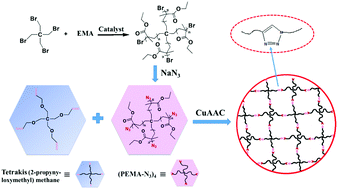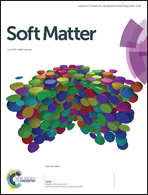A rapidly recoverable shape memory polymer with a topologically well-controlled poly(ethyl methacrylate) structure†
Abstract
Many of the unique properties of a conventionally crosslinked shape memory network are not found at the same time, and this is a large challenge for the development of advanced shape memory functional materials. In this work, a topologically well-controlled network shape memory poly(ethyl methacrylate) (CN-SMPEMA) is designed and fabricated by introducing two tetra-armed functional structures simultaneously as well-defined structure units to promote switch segment and net-point uniform distribution via the combined technology of the unique controllable atom transfer radical polymerization (ATRP) and copper(I)-catalyzed azide–alkyne cycloaddition (CuAAC). Compared with conventionally crosslinked networks, the as-prepared CN-SMPEMA not only exhibits a combination of excellent mechanical properties, shape fixity, shape recovery ratios and outstanding cycling stability, but also displays rapid recoverability. Additionally, a feasible molecular mechanism for the shape memory effect of the CN-SMPEMA system is analyzed and proposed. We anticipate that such a topologically well-defined network shape memory material with multiple excellent properties will broaden the practical application range of acrylate-based shape memory polymer materials.



 Please wait while we load your content...
Please wait while we load your content...